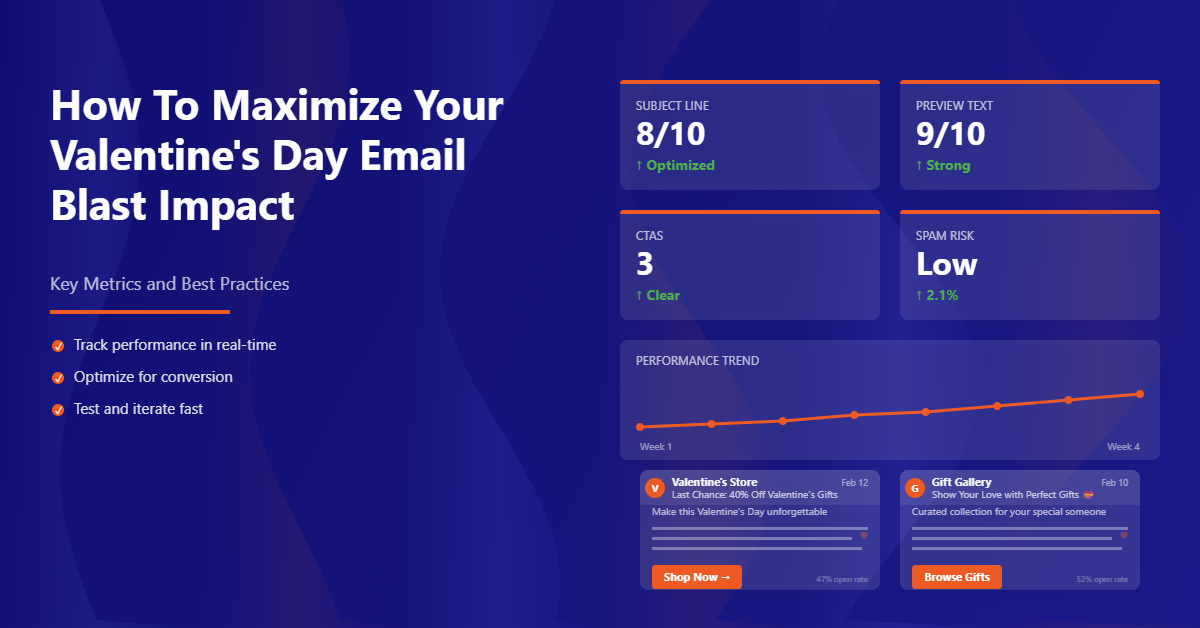Loyalty is a huge deal when it comes to keeping your customers around for the long haul, right? While a surprise reward here and there is nice, what you need for lasting customer love is a full-blown VIP Program. It’s how you keep your current customers hooked and stop them from looking elsewhere. Gone are the days of super simple loyalty programs; today, they need to be sophisticated to get people to sign up.

94% of Americans would like to take advantage of exclusivity ahead, like the VIP programs.
Ultimately, how you talk about your VIP Program, how you get customers involved, and how smoothly you run it will determine its success. Remember, you’re dealing with real people with unique desires, so don’t expect instant results. But with careful planning and execution, a fantastic VIP incentive program is totally achievable!
This guide will explain what a VIP program is, how it works, how you can create one, and 10 successful examples you can use for inspiration.
What Is A VIP Program?
A VIP program is a loyalty strategy where your best customers get exclusive rewards — think early access to products, special discounts, or members-only gifts. These programs are designed to make high-value customers feel recognized and appreciated.
How Does A VIP Program Work?
Most VIP programs operate on a straightforward, tiered system designed to reward customer loyalty and encourage continued engagement. The process typically unfolds as follows:
1. Customer Enrollment and Initial Engagement:
A customer begins their journey by either actively signing up for the VIP program or by initiating purchases that automatically enroll them. This initial step is crucial for capturing new participants and setting the stage for their progression within the program.
2. Qualification as a VIP:
As customers continue to interact with the brand, their spending habits and overall activity are meticulously tracked. Based on predefined criteria, such as a cumulative spending threshold, frequency of purchases, or engagement with specific services, they qualify as a VIP. This stage signifies a customer’s elevated status within the loyalty framework.
3. Exclusive Perks and Rewards:
The culmination of the VIP program is the bestowal of exclusive perks and rewards that acknowledge and reinforce the customer’s loyalty. These benefits can vary widely but commonly include:
- Early Access: Previews or early purchasing opportunities for new products, sales, or collections.
- Special Discounts: Enhanced discounts or personalized offers are not available to regular customers.
- Complimentary Services: Free shipping, personalized styling sessions, or dedicated customer support.
- Exclusive Events: Invitations to private sales, launch parties, or VIP-only gatherings.
- Personalized Experiences: Tailored recommendations, dedicated account managers, or customized gifts.
Benefits Of VIP Loyalty Programs
- Increased Retention: Customers feel appreciated and stick around longer.
- Higher CLV (Customer Lifetime Value): VIPs tend to spend more frequently and in larger amounts.
- Better Engagement: Personalized perks make customers more likely to open emails and return to the site.
- Brand Advocacy: VIPs often become vocal supporters, leaving reviews and referrals.
- Competitive Advantage: A well-structured VIP program sets you apart in saturated markets.
10 Highly Successful VIP Programs Examples
Here are 10 examples of successful VIP programs to inspire you as you design your loyalty program:
1. Starbucks Rewards
Starbucks rewards program needs no introduction. It is quite possibly the most popular and successful rewards program.
Starbucks rewards its customers for every purchase they make with the store. Once a customer has collected enough “Stars”, they can redeem them for an item of their choice. For example, a free Frappucino blended beverage.
The more stars you earn, the more rewards you can get!

With sustainability in consideration, Starbucks updated its terms and conditions increasing the number of “Stars” required to score a free item.
Although, how the program worked remained the same.
Customers can choose the payment option that will give them more points. These points (or Stars) also offer exclusive benefits like faster ordering and pick-up for VIP members.
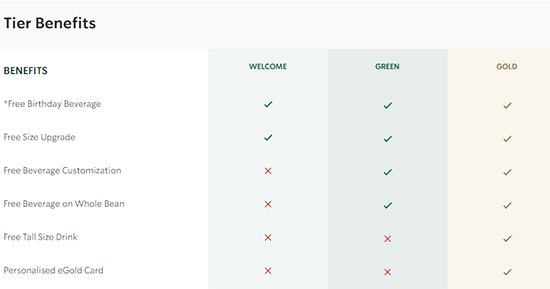
Starbucks launched an innovative VIP reward system with three tired reward programs: Welcome, Green, and Gold. It’s easy for customers to join and progress to the Welcome tier.
2. Sephora Beauty Insider
Sephora’s Beauty Insider is a VIP program that is massively successful with 25 million members and growing. This is clearly a result of how well Sephora understands its customer behavior psychology and how they used it to build a VIP Program
The Beauty Insider VIP program is straightforward, customers earn reward points with their purchases which they can redeem to purchase beauty products.
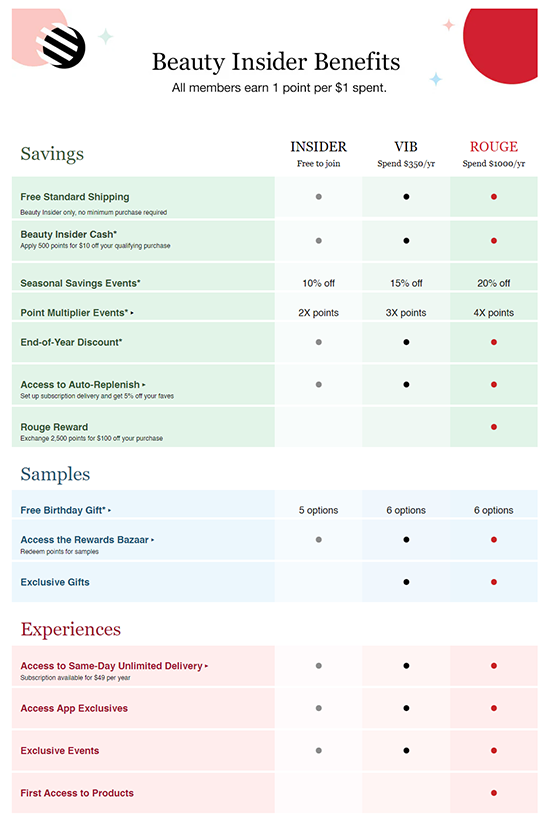
Making its customers come back for more, something to work towards adds another layer to the success of their VIP. That is, the three tiers: Insiders, VIPs, and Rogues.

The Rouge members, in the top tier, contribute significantly to the company’s sales and growth, as confirmed by Stanley.
Thanks to their gamification strategy, Beauty Insider Program is bringing in high customer engagement and encouraging them toward the next membership tier.
3. H&M Loyalty Program
H&M is effortlessly penetrating new markets, including the third-world markets, and scaling rapidly in the fast-fashion industry.
H&M has nearly eliminated the signup barrier to the loyalty program by making it a free program. Whereas keeping it simple with the point-based reward system sustains their high program engagement level.

The point system works like this, for every $1 a customer spends they earn 1 point, be it online or in-store.
Collaborating with Klarna allows customers to pay for their purchases in installments or up to 30 days later. Such careful attention to conversion barriers and enabling sales has made H&M loyalty programs increasingly successful.

Going to the basic understanding of its customer psychology to reinforce their customer loyalty they offer exclusive benefits via gamification to entice shoppers to return.
It includes an exclusive collaboration collection with world-renowned designers.
4. Chipotle Rewards
Following Starbucks, Chipotle Mexican Grill has taken up the VIP program in the scale for customer engagement and retention strategy for their brand. This customer loyalty program works on a point system, and the customers earn 10 points for every $1 spent in restaurants or online.

The Chipotle reward program has been boosted to 24 million members and is marked as one of the fastest-growing reward programs in the restaurant industry’s history. According to the chain, gamification has 74% better customer engagement.

The brand has added a new program to pull their customer interest in gamification with the extra personalized challenge to earn extra points to collect the “Achievement Badge.”
With the digital sale marked as $2 billion, chipotle has rolled out an extra feature of the VIP program to help members to earn free food faster.
5. Lego VIP
Similar to other brands’ VIP programs, Lego VIP also offers rewards as point based system. The points can be earned by purchasing the Lego toys by logging in to the website, completing the company survey, or following their social media account.

The Lego VIP program rewards can be redeemed in exchange for discounts or other benefits. It might sound simple, but the VIP program member receives exclusive perks. They get access to Lego sets early, enjoy many gifts, and receive monthly promotions and special offers.
6. Marriott’s Marriott Bonvoy
The point-based program is the most popular VIP program, as most brands follow it because it is easy to earn and redeem.
Customers can redeem the points on their next purchase with the brand, either it can be for discounts or giveaways. These VIP points are also easy to track; customers can do it online via a mobile app or loyalty card.

Marriott Bonvoy might look the same as other hotel VIP programs, but when you look closely into it, they have more tiers incorporated with exclusive benefits.
This proves that Marriott has taken gamification to the next level, making their customers engage better and also retain them from their competitors with the ultimate goal of making them reach the “ambassador elite.”
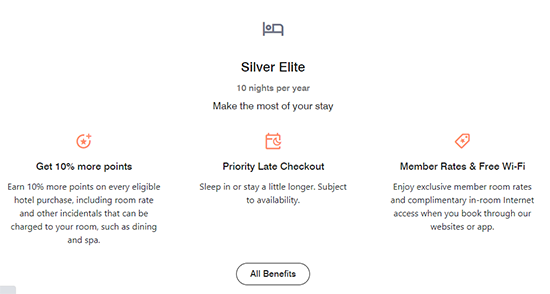
VIP program customers can earn points for various activities, including hotel stays, excursions, activities, and purchases made with the Marriott Bonvoy credit card. These collected points can be used to enjoy free hotel nights, meals, and other benefits.

7. Dose of Colors The Daily Dose Rewards
In the realm of online, there is plenty of beauty brands, from big brands like Sephora to smaller niche brands. These beauty brands strive to attract, engage and retain their loyal customers. In that way VIP program is an excellent way to do so.

Dose of Color is an American-based cruelty-free cosmetics company that is user-friendly, functional, and always on trend with the great VIP program.
The brand added an about us page with a small note from the founder and showcased the face behind this amazing product. Furthermore, they share their brand value in a creative acrostic poem style.
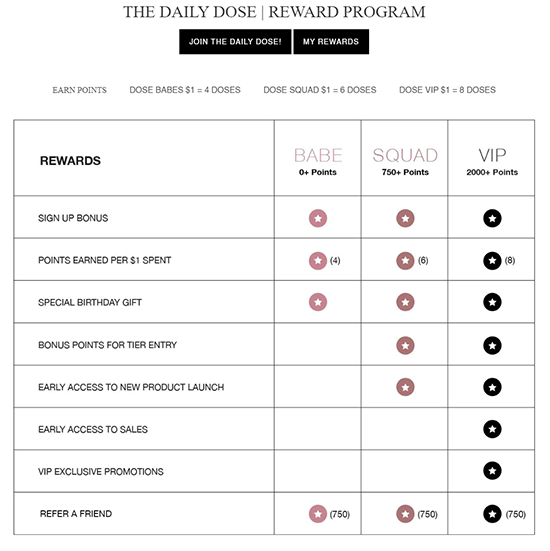
The Daily Dose reward program comes up with a 3-tier program – babe, squad, and VIP. The customer earns four doses for every $1 spent. If the customer is on the babe tier, they earn four doses for every $1 spent.
The Daily Dose reward program is easy and free to join, and customers can earn their doses immediately with no limit!

Customers can earn more doses by sharing and following the brand’s social handles. Moreover, the Dose of Colors offers extra points to the customers on their birthday only when they update their profile 30 days before the date.
Customers can redeem the points on their purchases and enjoy all perks and get access to the exclusive benefits of the brand.
8. Bank of America Preferred Rewards Program
Many financial institutions offer incentive programs to loyal customers to encourage them to do more business with their bank. One of the banks offering such rewards to their customers is Bank of America, which has joined the club by adding a “Preferred reward program” concept.
Bank of America, Preferred Reward program encourages customers to increase their assets holdings with Bank of America or Merrill Investments. To qualify for the program, customers should hold $20,000 combined deposits in Bank of America or Merrill Investment for over three months.

The preferred rewards VIP program offers eligible customers an increased interest rate on deposit accounts, credit card rewards, and reduced fees across Bank of America and Merrill Investment services.

The Bank of America has a four-tier preferred reward VIP membership: Gold, Platinum, Platinum Honors, and Diamond. All the benefits VIP program members must hold the qualifying combined balance in their account for the qualifying increase to the next tier.
If the balance drop below the preferred reward tier level you have achieved, the bank gives you 12 months and +3 months grace time to increase the balance amount to stay on that particular tier; else, you’ll be moved to the lower tier.
9. E.L.F Beauty Squad VIP Program
The cruelty-free cosmetics brand, e.l.f., has joined the VIP programs like other brands. In terms of encouraging its loyal customers, the brand has also followed the point-based system to make it simple for its customers to earn and redeem.
The brand offers its customers three tiers of loyalty programs: Fan, Pro, and Icon. Offering these tiering programs can help keep the customers engaged and increase their interest in gamification.
The more they play, the more they earn!

Beauty squad members earn points for shopping and engaging with e.l.f cosmetics by connecting on social media, writing a review signing up for email or text, and browsing on e.l.f. cosmetics.com, and more!
This clearly shows how the brand has powerfully linked gamification and customer engagement to stay at the top of their minds.
10. DSW VIP Program
DSW (Designer Shoe Warehouse), known for its wide variety of cost-effective footwear options, actively encourages customers to enroll in the complimentary DSW VIP program. It helps upgrade and upsell lower-tier customers to the next level of purchasing.

DSW has leaned heavily on gamification for the execution of their VIP program and it has given great rewards for the brand. But the one thing that needs to be appreciated is how it seamlessly aligns with DSW’s marketing strategy.

DSW offers a customer loyalty program with three tiers: VIP Club (free to join), VIP Gold (requires an annual spend of $200), and VIP Elite (requires an annual spend of $500). The core of these VIP programs remains the same. “The more you buy, the more points.”
Although, it differs in how each tier is rewarded. The Club and Gold members earn one point for every dollar spent, whereas the Elite members earn two points for every dollar spent.
How To Set Up Your First VIP Program
- Define Your Goals: What do you want to achieve—retention, revenue boost, referrals?
- Segment Your Audience: Use your CRM or platform like TargetBay to identify your top customers.
- Design Your Rewards: Choose what perks to offer—early access, exclusive products, special discounts, or events.
- Set Up Tiers (Optional): Make progression visible to incentivize behavior (e.g., Gold > Platinum > Elite).
- Choose the Right Tools: Use tools like TargetBay or Shopify Loyalty apps to automate.
- Promote the Program: Use email, SMS, and banners to make it known.
- Measure and Optimize: Track performance metrics like participation rate, repeat purchase rate, and average order value.
Common Mistakes To Avoid When Building Your VIP Loyalty Program
- Offering generic rewards that don’t excite
- Making it hard to join or understand
- Not promoting the program clearly
- Forgetting to update or refresh rewards
- Ignoring inactive VIPs
When building your VIP program, it’s easy to fall into common traps. Steering clear of these pitfalls will help ensure your program truly shines and resonates with your customers. Here are the mistakes to avoid while creating a VIP program for your business:
- Offering generic rewards that don’t excite: Your VIPs deserve more than just run-of-the-mill discounts. Think of unique experiences, early access, or personalized perks.
- Making it hard to join or understand: If customers can’t easily sign up or grasp the benefits, they simply won’t bother. Keep it simple and transparent.
- Not promoting the program clearly: Your amazing VIP program won’t get far if no one knows about it! Shout its benefits from the rooftops.
- Forgetting to update or refresh rewards: Stale rewards lead to dwindling interest. Keep things fresh and exciting to maintain engagement.
- Ignoring inactive VIPs: Don’t let your valuable VIPs fall by the wayside. Reach out, re-engage, and remind them why they’re special.
Takeaways
Alright, so here’s the big takeaway for VIP programs: forget just discounts! Moving forward, it’s all about making your customers feel special through exclusive experiences and emotional connections. That consistency is also foundational when you aim to build strong brand identity, ensuring every VIP touchpoint reinforces who you are and why customers should care.
Whether you’re just getting started or fine-tuning what you already have, the key is to offer genuine value and talk about it. Make your best customers feel truly like VIPs, and trust me, they’ll pay you back with incredible loyalty and become your biggest advocates!
A good place to start your loyalty program is by understanding your customer psychology and their expectations of your brand. It creates a VIP program that serves as a program of gratitude to your loyal customers who voluntarily become your brand advocates.
VIP Program FAQ
Why are VIP programs important to your business?
VIP programs help build stronger customer relationships, increase repeat purchases, and boost customer lifetime value. By offering exclusive perks, you give shoppers a reason to stay loyal, spend more, and feel valued—turning casual buyers into long-term brand advocates.
What’s the difference between a loyalty program and a VIP program?
Loyalty programs reward every customer, while VIP programs focus on top spenders or high-engagement users. VIP programs offer exclusive rewards, special treatment, and perks that aren’t available to all loyalty members.
How many VIP points is a dollar?
It depends on the brand’s loyalty setup, but a common structure is 1 point per $1 spent. Some programs offer bonus points for actions like referrals or reviews. For example, a VIP tier may give 1.5x or 2x points per dollar as an incentive to level up.
How do you make a customer feel like a VIP?
Make them feel special with early access, exclusive offers, personalized emails, and priority support. Use their name in communications, reward milestones (like birthdays or spending goals), and invite them to members-only events or previews.
What happens if my VIP membership expires?
Most VIP programs have rolling or calendar-based expiration policies. If you don’t earn or redeem points within a certain time (e.g., 12 months), your VIP status may downgrade, or points may expire. Some programs send reminders to stay active.
Can small businesses create a VIP program?
Absolutely. With tools like BayEngage, even small brands can launch simple VIP tiers with basic perks like free shipping, early access, or special discounts — without needing complex infrastructure.
Do VIP programs work for non-eCommerce brands?
Yes. SaaS companies, gyms, salons, and even digital services use VIP programs to boost engagement, reduce churn, and upsell higher-tier packages. The key is offering meaningful perks tied to customer behavior.





